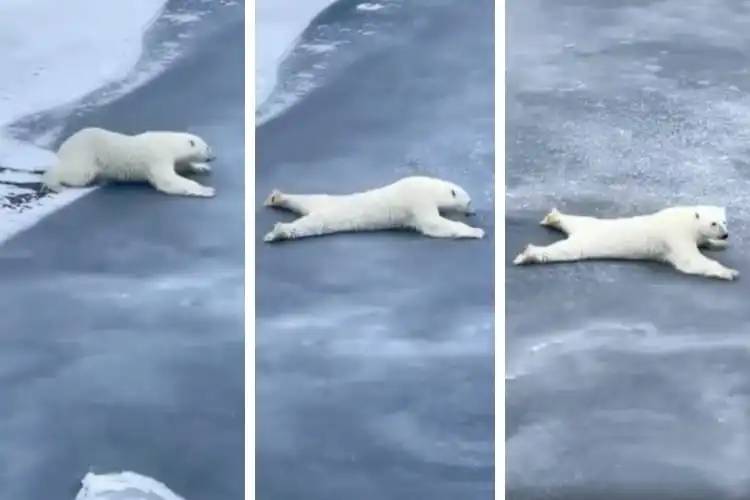Watch How Polar Bears Safely Navigate Thin Ice: A Lesson in Survival
Ice skating can be a thrilling activity, but it comes with a crucial caveat: the thickness of the ice. Just as cities meticulously measure ice to ensure the safety of their communities, polar bears also understand the dangers associated with thin ice. In a captivating viral video, we get a glimpse of how these magnificent creatures delicately cross frozen bodies of water without plunging into the icy depths.
Polar bears, despite their natural affinity for freezing environments, certainly do not relish the idea of falling into frigid waters. When faced with potentially perilous conditions, these intelligent animals employ a remarkable strategy to traverse thin ice safely. Instead of giving up or turning back, the polar bear redistributes its weight, minimizing the risk of breaking through. With outstretched limbs, it crawls cautiously until it deems the ice secure enough to resume its normal gait.
This ingenious approach follows a scientific principle expressed by the equation: Pressure equals force divided by area (P= F/A). In simpler terms, pressure is directly proportional to force but inversely proportional to area. As demonstrated by this bear’s behavior, maximizing the area (A) while minimizing the force (F) reduces pressure (P), increasing the likelihood of a safe journey across the ice.
P = F / A
— Massimo (@Rainmaker1973) March 20, 2023
This bear spotted crawling instead of walking on ice possibly learned that maximizing A and therefore reducing P, increases the chances to safely reach the snow
[Emma Postolec: https://t.co/HpSRhvqZUh]pic.twitter.com/P6fjWAmCmx
P = F / A
— Massimo (@Rainmaker1973) March 20, 2023
This bear spotted crawling instead of walking on ice possibly learned that maximizing A and therefore reducing P, increases the chances to safely reach the snow
[Emma Postolec: https://t.co/HpSRhvqZUh]pic.twitter.com/P6fjWAmCmx
While this video showcases the adaptability and intelligence of polar bears, it also underscores a pressing concern—the climate crisis is rapidly transforming the Arctic landscapes that these magnificent creatures call home. Although it remains unclear whether the ice this particular bear traverses has thinned due to seasonal changes or as a result of climate change, it serves as a poignant example of the challenges faced by Arctic fauna.
To ensure the safety and preservation of these remarkable creatures and their habitats, action must be taken to curb carbon emissions and halt the further melting of polar ice caps. By doing so, we can help polar bears and countless other species continue to thrive in their icy domains.

